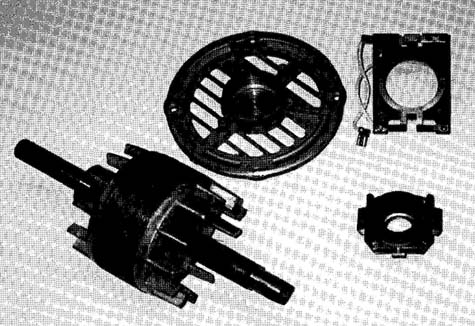AMAZON multi-meters discounts AMAZON oscilloscope discounts
Since the start winding can only stay in the circuit for a short time because its wire is too small and it will heat up rapidly, a switch is provided to disconnect it from the circuit as soon as the motor is started. This switch is a centrifugal switch that mechanically senses the speed of the shaft and opens when the shaft reaches approximately 90 - 95% of full rpm. Fig. 1a shows a picture of the end switch and Fig. 1b shows the end switch mounted in the end plate. Fig. 1c shows the actuator that moves the centrifugal switch open when the proper speed is reached and allows the switch to close when the motor stops. Fig. 1d shows the actuator mounted on the motor shaft.

Above: Fig. 1: A centrifugal switch removed from its end plate. The
flyweight mechanism has also been removed from the motor shaft.
The centrifugal switch is mounted in the rear end plate. It's commonly referred to as the end switch. The switch has two distinct parts, the switch and actuator, The switch is mounted in the end plate, and the actuator is mounted on the rotor shaft so that it will come in contact with the end switch when the rotor reaches full rpm. The switch is shown removed from the end plate in Fig. 1a and it's shown mounted in the end switch in Fig. 1b.
The end switch is made of spring steel, which provides tension to keep the switch contacts closed. Whenever the centrifugal actuator is not pressing on the switch, the contacts will remain in the closed position. When the actuator moves along the shaft slightly, it will provide enough force to cause the switch contacts to snap open.
In Fig. 1c notice that the actuator has a weight built into its outer edges. These weights, called flyweights, are hinged on the inside near the rotor and allowed to move or swing at the outer edge. Since the outer edge is heavier, the centrifugal force caused by the shaft rotation will cause them to move away from the shaft. Since the actuator is hinged to the inside, this action will cause the actuator to move along the length of the shaft slightly in the direction of the switch. The movement is only 0.5 to 0.75 inch, but it's sufficient to actuate the end switch to the open position. Fig. 1d shows the actuator mounted on the shaft.
Since the flyweights snap over center to overcome the return spring's tension, one will hear a distinct snap when the motor reaches approximately 95% full speed, which indicates that the end switch has opened, and again after the motor is deenergized and the rotor shaft is coasting to a stop. When you hear the snap as the motor is coasting to a stop, it indicates that the end switch has returned to its closed position.
When the motor is de-energized, the rotor will decelerate to a stop and the centrifugal actuator will return to its original position with the aid of return springs. When the flyweights return to their normal position, the actuator moves back away from the switch and allows it to return to its closed position so that it's ready for the next time the motor is started.